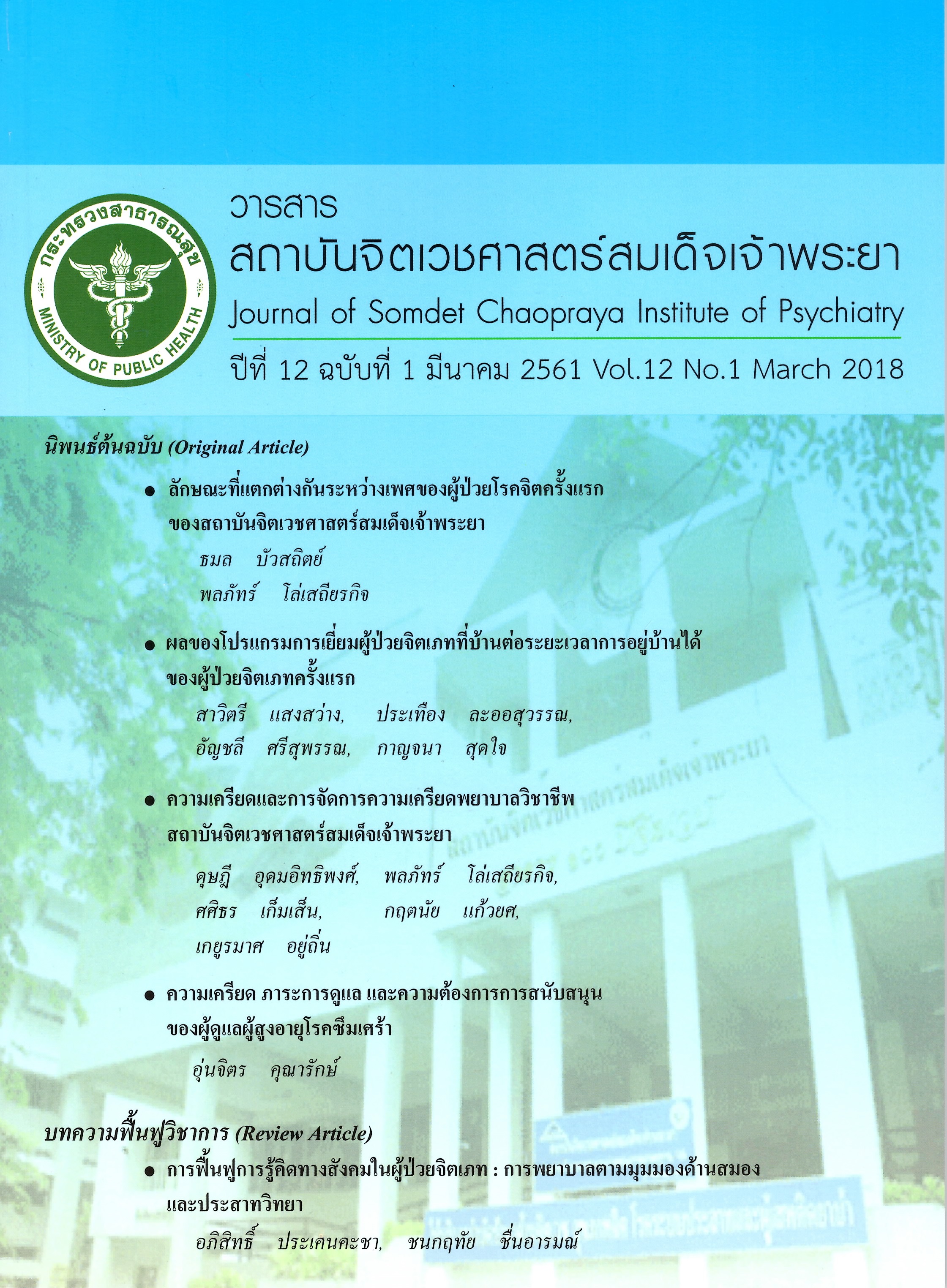การฟื้นฟูการรู้คิดทางสังคมในผู้ป่วยจิตเภท: การพยาบาลตามมุมมองด้านสมองและประสาทวิทยา
คำสำคัญ:
การฟื้นฟูการรู้คิดทางสังคม, ผู้ป่วยจิตเภท, สมองและประสาทวิทยาบทคัดย่อ
วัตถุประสงค์ : เพื่อทบทวนวรรณกรรมพยาธิสภาพในโรคจิตเภทที่เชื่อมโยงกับการพร่องหน้าที่ของสมองด้านการรู้คิดทางสังคม แนวคิดการฝึกทักษะปฏิสัมพันธ์ทางสังคมในผู้ป่วยโรคจิตเภท และการประยุกต์ใช้ในการพยาบาล
วัสดุและวิธีการ : เป็นการทบทวนวรรณกรรมที่เกี่ยวข้องกับการรู้คิดทางสังคมและการมีปฏิสัมพันธ์ทางสังคมของผู้ป่วยจิตเภทจากเอกสารวิชาการ นิพนธ์ต้นฉบับ วารสารออนไลน์ และบทความวิจัยที่รวมถึงการวิจัยอย่างเป็นระบบและการวิเคราะห์อภิมานถึงประสิทธิผลของโปรแกรมการฝึกทักษะปฏิสัมพันธ์ทางสังคมทั้งหมด 13 เรื่อง
ผล : การเจ็บป่วยด้วยโรคจิตเภทก่อให้เกิดความเสียหายทางโครงสร้างและการทำหน้าที่ของสมองที่รับผิดชอบทักษะปฏิสัมพันธ์ทางสังคมหลายด้าน ทั้งการรับรู้อารมณ์ทางใบหน้า การเข้าใจความคิดความรู้สึกของบุคคลอื่น และการแปลความเจตนาบุคคลอื่น การศึกษาในปัจจุบันพบว่าการฝึกทักษะปฏิสัมพันธ์ทางสังคมส่งผลให้ผู้ป่วยจิตเภทมีการรับรู้อารมณ์ทางใบหน้าที่ดีขึ้น แต่การรับรู้ใบหน้าที่ดีขึ้นนี้สัมพันธ์อย่างไม่มีนัยสำคัญกับการเข้าใจความคิดความรู้สึกและการแปลความตั้งใจของบุคคลอื่น ทั้งนี้ อาจเป็นเพราะการคาดเดาและแปลความเจตนาของผู้อื่นนั้น ต้องพึ่งพาความสามารถด้านการรู้คิดเชิงบริหารร่วมด้วย
สรุป : ในการดูแลเพื่อฟื้นฟูสมรรถภาพด้านการรู้คิดทางสังคมของผู้ป่วย พยาบาลควรใช้ตนเองเป็นต้นแบบที่ดีในการรับรู้อารมณ์และแสดงความรู้สึก มีความสอดคล้องกันของคำพูดและการแสดงออก จัดสิ่งแวดล้อมที่กระตุ้นปฏิสัมพันธ์ทางสังคม ให้การสะท้อนกลับถึงทักษะพื้นฐานปฏิสัมพันธ์อย่างสม่ำเสมอ และจัดกิจกรรมกระตุ้นการมีปฏิสัมพันธ์ให้เหมาะสมกับระดับการสูญเสียความสามารถของโรคผู้ป่วยจิตเภทแต่ละคน
เอกสารอ้างอิง
Erikson, E. Identity and the life cycle. New York: Norton; 1980.
Siegel, D. The Neurobiology of ‘We’: How relationships, the mind, and the brain interact to Shape Who We Are. Sounds True Inc; 2008.
Siegel, DJ. Pocket guide to interpersonal neurobiology: An integrative handbook of the mind. New York: W.W. Norton & Company; 2012.
Dunlop J, Brandon NJ. Schizophrenia drug discovery and development in an evolving era: are new drug targets fulfilling expectations? J Psychopharmacol 2015; 29(2): 230-8.
Turner DT, McGlanaghy E, Cuijpers P. A meta-analysis of social skills training and related interventions for psychosis. Schizophr Bull 2018; 44(3): 475–91.
Javed A, Charles A. The importance of social cognition in improving functional outcomes in schizophrenia. Front Psychiatry 2018; 24(9): 157.
Maslow, AH. A theory of human motivation. Psychol Rev 1943; 50(4): 370–96.
Harry F. Harlow, Stephen J. Suomii. Social recovery by isolation-reared monkeys. Proceedings of the National Academy of Sciences of the USA 1971; 68(7): 1534-38.
James E. Swain, James F. Leckman, Fred R. Volkmar. The wolf boy reactive attachment disorder in an adolescent boy. Psychiatry 2005; 11: 55-61.
Panksepp J. Foreword to Cory G, Gardner R. The evolutionary neuroethology of Paul MacLean: Convergences and Frontiers; 2002.
Davidson R J, Begley S. The emotional life of your brain: How its unique patterns affect the way you think, feel, and live--and how you can change them. New York: Hudson Street Press; 2012.
Schore JR, Schore AN. Modern attachment theory: The central role of affect regulation in development and treatment. Clin Soc Work J 2008; 36: 9.
Butler AB. Evolution of brains, cognition, and consciousness. Brain Res Bull 2008; 18: 75(2-4): 442-9.
Frith U, Frith C. The social brain: allowing humans to boldly go where no other species has been. Philos Trans R Soc Lond B Biol Sci 2010; 12: 165-76.
Todd K, Shackelford James R, Liddle. Understanding the mind from an evolutionary perspective: an overview of evolutionary psychology. Wiley Interdiscip Rev Cogn Sci 2014; 5(3): 247-60.
Frith CD, Frith U. Social cognition in humans. Curr Biol 2007; 17(16): 724-32.
Lindsey J. Byom Bilge Mutlu. Theory of mind: mechanisms, methods, and new directions Front Hum Neurosci 2013; 7: 1-12.
Patricia L. Lockwood. The anatomy of empathy: Vicarious experience and disorders of social cognition. Behav Brain Res 2016; 15: 255–266.
Brain anatomy coloring pages 98 idea brain anatomy coloring pages. 2015. [online]. Available from: http://speechfoodie.com/brain-anatomy-coloring-pages [2018 march 10].
David D, Laura MT, Sarah HL, Christine IH. The neural basis of theory of mind and its relationship to social functioning and social anhedonia in individuals with schizophrenia. Neuroimage Clin 2014; 154–63.
Frith CD, Frith U. Mechanisms of social cognition. Annu Rev Psychol 2012; 63: 287-313.
Hironobu F, Cali B. Neural basis for social cognitive impairment in schizophrenia. J Bras Psiquiatr 2010; 59(2): 85-7.
Siegel DJ. An interpersonal neurobiology approach to psychotherapy: How awareness, mirror neurons and neural plasticity contribute to the development of well-being. Psychiatr Ann 2006; 36(4): 248-58.
Pinkham A, Penn D, Perkins D, Lieberman J. Implications of a neural basis for social cognition for the study of schizophrenia. Am J Psychiatry 2003; 160(58): 815-824.
Penn D, Roberts DL, Munt ED, Silverstein E, Jones N, Sheitman B. A pilot study of social cognition and interaction training (SCIT) for schizophrenia. Schizophr Res 2005; 80 (2-3): 357-9.
Combs DR, Adams SD, Penn DL, Roberts D, Tiegreen J, Stem P. Social Cognition and Interaction Training (SCIT) for inpatients with schizophrenia spectrum disorders: preliminary findings. Schizophr Res 2007; 91(1-3): 112-6.
Roberts DL, Penn DL. Social Cognition and Interaction Training (SCIT) for outpatients with schizophrenia: a preliminary study. Psychiatry Res 2009; 166: 141–147.
Combs DR, Elerson K, Penn DL, Tiegreen JA, Nelson A, Ledet SN, Basso MR. Stability and generalization of Social Cognition and Interaction Training (SCIT) for schizophrenia: six-month follow-up results. Schizophr Res 2009; 112(1-3): 196-7.
Horan WP, Robert S, Kern, Karina Shokat-Fadai, Mark J, Sergi, Jonathan K, Michael F, Green, et al. Social cognitive skills training in schizophrenia: An initial efficacy study of stabilized outpatients. Schizophr Res 2009; 107(1): 47–54.
Roberts DL, Penn DL, Labate D, Margolis SA, Sterne A. Transportability and feasibility of Social Cognition and Interaction Training (SCIT) in community settings. Behav Cogn Psychother 2010; 38(1): 35-47.
Matthew M. Kurtz, Christi L. Richardson. Social cognitive training for schizophrenia: A meta-analytic investigation of controlled research. Schizophr Bull 2012; 5(38): 1092–1104.
Horan WP, Green MF, DeGroot M. Social cognition in schizophrenia, part 2: 12-month stability and prediction of functional outcome in first-episode patients. Schizophr Bull 2012; 38: 865–72.
Parker S, Foley S, Walker P, Dark F. Improving the social cognitive deficits of schizophrenia: a community trial of Social Cognition and Interaction Training (SCIT). Australas Psychiatry 2013; 21(4): 346-51.
Wang Y, Roberts DL, Xu B, Cao R, Yan M, Jiang Q. Social cognition and interaction training for patients with stable schizophrenia in Chinese community settings. Psychiatry Res 2013; 210(3): 751-5.
Voutilainen G, Kouhia T, Roberts DL, Oksanen J. Social cognition and interaction training (SCIT) for adults with psychotic disorders: A feasibility study in Finland. Behav Cogn Psychother 2016; 44(6): 711-6.
Taylor R, Cella M, Csipke E, Heriot-Maitland C, Gibbs C, Wykes T. Tackling social cognition in schizophrenia: A randomized feasibility trial. Behav Cogn Psychother 2016; 44(3): 306-17.
Gordon A, Davis PJ, Patterson S, Pepping CA, Scott JG, Salter K, Connell M. A randomized waitlist control community study of social cognition and interaction training for people with schizophrenia. Br J Clin Psychol 2018; 57(1): 116-30.
ดาวน์โหลด
เผยแพร่แล้ว
รูปแบบการอ้างอิง
ฉบับ
ประเภทบทความ
สัญญาอนุญาต
บทความที่ได้รับการตีพิมพ์เป็นลิขสิทธิ์ของวารสารสถาบันจิตเวชศาสตร์สมเด็จเจ้าพระยา



